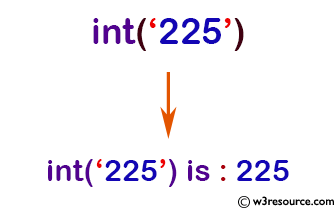Python: int() function
int() function
The int() function converts the specified value into an integer number.
The int() function returns an integer object constructed from a number or string x, or return 0 if no arguments are given.
Version:
(Python 3.2.5)
Syntax:
int(x=0) int(x, base=10)
Parameter:
| Name | Description | Required / Optional |
|---|---|---|
| x | A number or string to be converted to integer object. Default argument is zero. | Required |
| base | Number format. Default value: 10. | Optional |
Return value:
If x is a number, return x.__int__().
Example: Python int() function
# integer
print("int(225) is:", int(225))
Output:
int(225) is: 225
Pictorial Presentation:

Example: Python int() function with String
# string
print("int('225') is:", int('225'))
Output:
int('225') is: 225
Example: Python int()function with float
# float
print("int(225.25) is:", int(225.25))
Output:
int(225.25) is: 225
Python Code Editor:
Previous: input()
Next: isinstance()
Test your Python skills with w3resource's quiz
